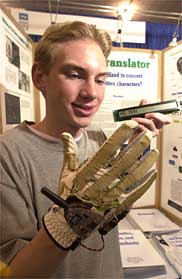MINDY SINK . NY Times . 07 february 2002
 INVENTOR Ryan Patterson outfitted a golf glove with sensors |
NECESSITY may have been the mother of Ryan Patterson's invention, but hunger played a role, too.
Mr. Patterson, 17, was at a Burger King restaurant in the summer of 2000 in his hometown of Grand Junction, Colo., when he saw a group of deaf people buying their meals. Rather than try to communicate with the cashier, they used sign language with a speaking person who placed their orders for them.
Out of that experience Mr. Patterson, a high school senior, developed a sensor glove that can take the finger movements of American Sign Language and translate them into text on a small display screen. The invention earned him a top award in December in the Siemens Westinghouse Science and Technology Competition and similar honors last spring at the Intel (news/quote) International Science and Engineering Fair.
Mr. Patterson did not know anyone who was deaf or mute. Nor did he know any sign language. But aside from his experience at the Burger King, he had read about a student in Grand Junction who had an adult translator with her in high school, with the school district picking up the cost.
"There is a very high demand for translators, and they are very expensive and hard to find," he said. "I thought this might be a way for them to be more independent."
So using a golf glove, a circuit board, a laptop computer and some basic electronic parts, Mr. Patterson, who worked on his first electronics project at age 5, created the Sign Translator for a local science fair. He has since refined the device, replacing the laptop with a small wireless receiver and display unit, and applied for a patent for it. One company has inquired about manufacturing the glove, he said, but he is looking into doing that himself.
In conceiving the project, Mr. Patterson realized that he would need sensors that could read the positions of the fingers. But the sensors, flexible strips of carbon-coated plastic that act as variable resistors, needed to be attached to something. He chose a golf glove because it has full fingers and is made from thin leather, making each sign easier to discern. Thinness also proved useful when the 10 sensors were sewn on the glove's fingers and wrist.
But how could a computer know whether a hand was shaping a B or an E? Mr. Patterson designed a software program that could "learn" individual letters or words, making calculations based on the distance between the fingers and hand. A small processor and transmitter attached to the back of the glove send signals to the display unit.
Because people's hands vary in size and because signing, much like voice inflection, can vary from person to person, the software learns an individual's quirks over time. Then the glove is ready to go into action, translating finger movements in about one-fifth of a second.
Mr. Patterson said that the device was not intended for one-sided, brief interactions. "It's for running errands like going to the cleaners or ordering food or being in the classroom," he said. "There's no replacement for a human translator, and people who can't speak are going to need one at some point."
Technology has already found a niche in the deaf and nonspeaking world. "This sounds a little like our digital pagers, which are ubiquitous on campus right now," said Mercy Coogan, director of public relations at Gallaudet University in Washington, which was founded exclusively for the deaf and hard of hearing. "This device sounds like people would no longer have to fidget around for pencil and paper to write things down when they want to communicate."